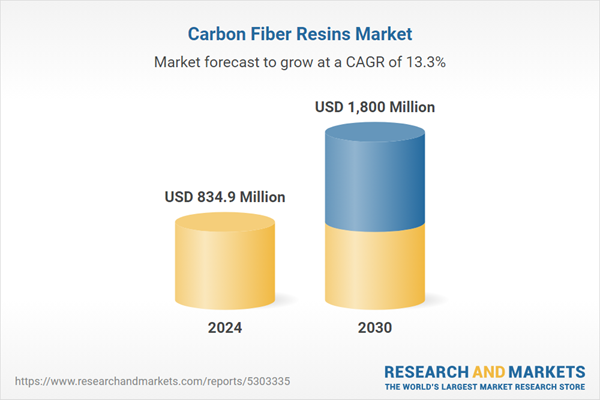Global Carbon Fiber Resins Market - Key Trends & Drivers Summarized
Why Are Carbon Fiber Resins Gaining Popularity Across Multiple Industries?
Carbon fiber resins are becoming increasingly important in a wide range of industries due to their unique combination of strength, lightweight properties, and durability. Carbon fibers are reinforced with various resin systems, such as epoxy, polyester, and vinyl ester, to form composites that exhibit high mechanical strength, thermal stability, and corrosion resistance. These carbon fiber-reinforced polymers (CFRPs) are used in industries ranging from aerospace and automotive to construction, sports equipment, and renewable energy. The growing demand for lightweight, high-performance materials in these sectors is fueling the adoption of carbon fiber resins, particularly as industries seek to enhance fuel efficiency, reduce emissions, and improve product performance.In the aerospace and automotive industries, carbon fiber resins are prized for their ability to reduce vehicle weight without compromising structural integrity. This reduction in weight translates into improved fuel efficiency and reduced CO2 emissions, which is especially critical in the aerospace sector where weight savings can lead to significant operational cost reductions. Similarly, in the automotive industry, lightweight CFRP components are being used in high-performance vehicles and electric cars to enhance acceleration, handling, and overall energy efficiency. As industries prioritize sustainability and high performance, carbon fiber resins have become indispensable in designing next-generation products.
How Are Technological Advancements Shaping the Carbon Fiber Resins Market?
Technological advancements are playing a critical role in improving the manufacturing processes and performance characteristics of carbon fiber resins, making them more cost-effective and adaptable to various applications. Innovations in resin formulation, particularly in epoxy resins, have enhanced the mechanical properties of carbon fiber composites, offering better adhesion, flexibility, and toughness. Additionally, advancements in fast-curing resins and automated manufacturing processes, such as resin transfer molding (RTM) and automated fiber placement (AFP), have streamlined production, reducing labor costs and making CFRPs more accessible for mass-market applications.In the renewable energy sector, for instance, advancements in resin technology are making wind turbine blades stronger and lighter, enabling the construction of larger turbines that can generate more power. Similarly, the aerospace industry is benefitting from innovations in high-temperature resins that allow carbon fiber composites to perform in extreme conditions, such as in jet engines and aircraft fuselages. Furthermore, the development of bio-based and recyclable resins is addressing environmental concerns by making carbon fiber composites more sustainable and eco-friendly. These technological improvements are driving the expansion of carbon fiber resins into new applications, ensuring their continued relevance in high-performance industries.
What Consumer Trends Are Driving the Demand for Carbon Fiber Resins?
Consumer preferences are increasingly driving the demand for carbon fiber resins, particularly in sectors like automotive, sports equipment, and electronics, where lightweight, durable, and high-performance materials are in demand. In the automotive industry, consumers are seeking vehicles that are not only fuel-efficient but also high-performing, and carbon fiber components are delivering on both fronts. Electric vehicles (EVs), in particular, are benefiting from the use of carbon fiber composites, which help offset the weight of heavy batteries, improving the overall range and efficiency of EVs. With the rise of sustainability and energy efficiency trends, consumer demand for lightweight and environmentally friendly materials is growing, pushing automakers to adopt carbon fiber resins more widely.The sports equipment industry is another area where consumer trends are shaping demand. Athletes and enthusiasts are increasingly seeking high-performance gear, such as bicycles, tennis rackets, and golf clubs, made with carbon fiber resins due to their superior strength-to-weight ratio and enhanced performance characteristics. In the electronics sector, the trend toward sleek, lightweight, and durable consumer gadgets has led manufacturers to explore carbon fiber composites for use in smartphones, laptops, and other personal electronics. This combination of performance, durability, and aesthetic appeal is driving the adoption of carbon fiber resins in consumer-facing products, as customers are willing to pay a premium for materials that offer both functionality and style.
Growth in the Carbon Fiber Resins Market Is Driven by Several Factors
Growth in the carbon fiber resins market is driven by several factors, including technological advancements, the rising demand for lightweight materials, and increasing applications in high-growth industries such as aerospace, automotive, and renewable energy. One of the key drivers is the push toward fuel efficiency and emissions reduction in the transportation sector. Aerospace and automotive manufacturers are increasingly adopting carbon fiber resins to produce lighter components that reduce fuel consumption and meet stringent environmental regulations. The growing demand for electric vehicles (EVs) is particularly significant, as carbon fiber resins help optimize the weight and performance of these vehicles, enhancing their energy efficiency and driving range.Another important driver is the expansion of renewable energy projects, especially in wind energy. Carbon fiber resins are used to manufacture lightweight and durable wind turbine blades, which are critical for the efficient generation of wind power. As the global focus on renewable energy intensifies, the demand for carbon fiber resins in wind power applications is expected to grow substantially. Furthermore, the increasing focus on sustainability and recyclability is leading to the development of bio-based and recyclable resin systems, opening new growth opportunities in sectors that prioritize environmental impact.
Finally, the rising adoption of carbon fiber resins in the sports, consumer electronics, and construction sectors is boosting market growth. Consumers are increasingly seeking high-performance, durable materials for products ranging from sports equipment to smartphones, further driving demand for carbon fiber resins. As these industries continue to innovate and adopt carbon fiber composites, the market for carbon fiber resins is expected to expand, supported by technological advances, regulatory pressures, and evolving consumer preferences
Report Scope
The report analyzes the Carbon Fiber Resins market, presented in terms of units. The analysis covers the key segments and geographic regions outlined below.Segments: Resin Type (Thermoset, Thermoplastic); Form (Prepreg, Non-Prepreg); Application (Aerospace & Defense, Automotive, Wind Energy, Sporting Goods, Other Applications).
Geographic Regions/Countries: World; United States; Canada; Japan; China; Europe (France; Germany; Italy; United Kingdom; and Rest of Europe); Asia-Pacific; Rest of World.
Key Insights:
- Market Growth: Understand the significant growth trajectory of the Thermoset segment, which is expected to reach US$1.1 Billion by 2030 with a CAGR of a 13.1%. The Thermoplastic segment is also set to grow at 13.7% CAGR over the analysis period.
- Regional Analysis: Gain insights into the U.S. market, valued at $229.7 Million in 2024, and China, forecasted to grow at an impressive 12.6% CAGR to reach $272.3 Million by 2030. Discover growth trends in other key regions, including Japan, Canada, Germany, and the Asia-Pacific.
Why You Should Buy This Report:
- Detailed Market Analysis: Access a thorough analysis of the Global Carbon Fiber Resins Market, covering all major geographic regions and market segments.
- Competitive Insights: Get an overview of the competitive landscape, including the market presence of major players across different geographies.
- Future Trends and Drivers: Understand the key trends and drivers shaping the future of the Global Carbon Fiber Resins Market.
- Actionable Insights: Benefit from actionable insights that can help you identify new revenue opportunities and make strategic business decisions.
Key Questions Answered:
- How is the Global Carbon Fiber Resins Market expected to evolve by 2030?
- What are the main drivers and restraints affecting the market?
- Which market segments will grow the most over the forecast period?
- How will market shares for different regions and segments change by 2030?
- Who are the leading players in the market, and what are their prospects?
Report Features:
- Comprehensive Market Data: Independent analysis of annual sales and market forecasts in US$ Million from 2024 to 2030.
- In-Depth Regional Analysis: Detailed insights into key markets, including the U.S., China, Japan, Canada, Europe, Asia-Pacific, Latin America, Middle East, and Africa.
- Company Profiles: Coverage of players such as 3M Company, Aker Solutions, Aliancys, Alpha Owens-Corning, Ashland Inc. and more.
- Complimentary Updates: Receive free report updates for one year to keep you informed of the latest market developments.
Some of the 47 companies featured in this Carbon Fiber Resins market report include:
- 3M Company
- Aker Solutions
- Aliancys
- Alpha Owens-Corning
- Ashland Inc.
- BASF SE
- Exxon Mobil
- Fluor Corporation
- General Electric
- Halliburton
- Hexion Inc.
- Huntsman Corporation
- Kukdo Chemical Co. Ltd
- Linde
- NRG Energy, Inc.
- Olin Corporation
- Polynt S.P.A.
- Schlumberger Limited
- Shell Cansolv
- Siemens
Tariff Impact Analysis: Key Insights for 2025
Global tariff negotiations across 180+ countries are reshaping supply chains, costs, and competitiveness. This report reflects the latest developments as of April 2025 and incorporates forward-looking insights into the market outlook.The analysts continuously track trade developments worldwide, drawing insights from leading global economists and over 200 industry and policy institutions, including think tanks, trade organizations, and national economic advisory bodies. This intelligence is integrated into forecasting models to provide timely, data-driven analysis of emerging risks and opportunities.
What’s Included in This Edition:
- Tariff-adjusted market forecasts by region and segment
- Analysis of cost and supply chain implications by sourcing and trade exposure
- Strategic insights into geographic shifts
Buyers receive a free July 2025 update with:
- Finalized tariff impacts and new trade agreement effects
- Updated projections reflecting global sourcing and cost shifts
- Expanded country-specific coverage across the industry
Table of Contents
Companies Mentioned (Partial List)
A selection of companies mentioned in this report includes, but is not limited to:
- 3M Company
- Aker Solutions
- Aliancys
- Alpha Owens-Corning
- Ashland Inc.
- BASF SE
- Exxon Mobil
- Fluor Corporation
- General Electric
- Halliburton
- Hexion Inc.
- Huntsman Corporation
- Kukdo Chemical Co. Ltd
- Linde
- NRG Energy, Inc.
- Olin Corporation
- Polynt S.P.A.
- Schlumberger Limited
- Shell Cansolv
- Siemens
Table Information
| Report Attribute | Details |
|---|---|
| No. of Pages | 96 |
| Published | April 2025 |
| Forecast Period | 2024 - 2030 |
| Estimated Market Value ( USD | $ 834.9 Million |
| Forecasted Market Value ( USD | $ 1800 Million |
| Compound Annual Growth Rate | 13.3% |
| Regions Covered | Global |









